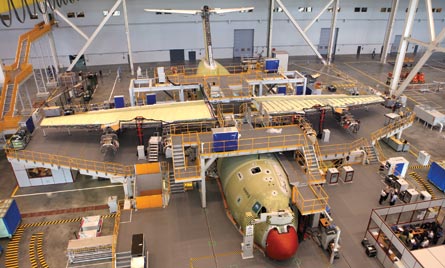The A400M will be flown by non-Airbus pilots for the first time in the next few weeks as the flight-test department strives to make up for time lost to bad weather and move the programme into its "certification phase" by September.
With around 50h of flying notched up, Airbus's vice-president flight-test division Fernando Alonso says the programme is going according to plan, with aerodynamic performance "very clean" and "showing no anomalies". MSN001 - which first took to the air on 11 December - shifted test centres from Seville to Toulouse on 9 March to take its number of flights into double figures, and MSN002 took its final steps towards an expected first flight around the turn of the month with a trial to run all four engines on 18 March.
 Station 40 in the final assembly line, where wings, fuselage and empennage come together. Photo: Airbus Military |
|---|
Alonso expects officials from the European Aviation Safety Agency to begin the certification process shortly by flying alongside Airbus Military pilots. The company is keen to involve regulators as soon as possible. "We don't just believe in presenting the product to the authorities at the end," he says.
Without an unusually wet winter in southern Spain, Airbus Military would have by mid-March made around 25 flights - rather than 10 - and be flying four or five times a week. However, Alonso says: "We will catch up." The flight-test team has been constrained by the need to map the stresses on the propellers. Because the strain gauges are glued to the surface of the blades, the aircraft cannot fly through rain or heavy clouds. Alonso expects to remove these test blades by the end of the month.
He says that the delays caused by the integration of the engine - which stalled the programme by more than two years - have helped Airbus Military finesse other elements of the aircraft. "We have better maturity levels than we have seen on previous programmes," he says. "[The A400M] behaves like we have seen in the simulator, which is encouraging."
This is a trend that emerged with the A380 flight-test programme, adds Alonso. "One lesson from the A380 is that the accuracy of predictions is so phenomenal these days. In the past when we used windtunnel tests, we had to tweak and optimise lots of things in flight. This sort of accuracy shortens the flight-test period considerably."
The aircraft has flown at its maximum operating speed of 300kt (555km/h) or M0.72, and down to the stall warning, and at more than 30,000ft (9,150m).
STALL TESTS
Next on the agenda for MSN001 are stall tests ahead of the installation of an anti-deep stall recovery system. The aircraft has flown without one of its four engines running, and will shortly fly with power from only two engines. The ram air turbine has been tested.
"The engines are working fine," says Alonso. "We had some trouble with FADEC issues, but have adjusted the software." There have also been simulated hydraulic failures. "We have switched off both systems so the aircraft has been flying in total electronic configuration. The airplane can survive dual hydraulic failure, which is an absolute non-event," says Alonso.
MSN002 flight testing will focus on take-off, climb and cruise performance to establish the flight manual and validate the flap/slat configuration.
MSN001 will spend most of its flight-test schedule in Toulouse, but will return to Seville for specific campaigns. MSN002 will remain in Seville and there is a possibility MSN003 will take off for the first time from Spain and land in France, where it will be based, says Alonso. The fourth aircraft will stay in Seville, with the final test aircraft going to Toulouse.
Because the two flight-test centres are interchangable and connected via telemetry to the aircraft and other Airbus engineering centres, staff in Bremen, Filton, Hamburg, Seville and Toulouse can follow flights in real time and debrief by video conference, saving time and money in flying different teams to France for each stage of flight testing. "It cancels the disadvantages of geographical separation," says Alonso.
After such a long delay to first flight, he is determined now not to let the momentum slip. "These first six months are crucial to beat the hell out of the airplane and take it to its limits," he says. "The sooner we find anything that doesn't work the better. Once we are in our certification period, it becomes more complicated."
Source: Flight International























